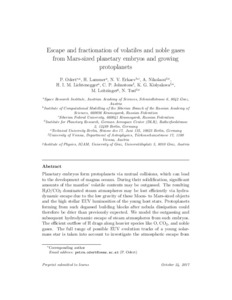Показать сокращенную информацию
Escape and fractionation of volatiles and noble gases from Mars-sized planetary embryos and growing protoplanets
| Автор | Odert, P. | |
| Автор | Lammer, H. | |
| Автор | Erkaev, N. V. | |
| Автор | Nikolaou, A. | |
| Автор | Lichtenegger H. I. M. | |
| Автор | Johnstone, C. P. | |
| Автор | Kislyakova, K. G. | |
| Автор | Leitzinger, M. | |
| Автор | Tosi, N. | |
| Дата внесения | 2019-07-01T07:29:11Z | |
| Дата, когда ресурс стал доступен | 2019-07-01T07:29:11Z | |
| Дата публикации | 2018 | |
| Библиографическое описание | Odert, P. Escape and fractionation of volatiles and noble gases from Mars-sized planetary embryos and growing protoplanets [Текст] / P. Odert, H. Lammer, N. V. Erkaev, A. Nikolaou, Lichtenegger H. I. M., C. P. Johnstone, K. G. Kislyakova, M. Leitzinger, N. Tosi // Icarus. — 2018. — Т. 307. — С. 327-346 | |
| ISSN | 00191035 | |
| URI (для ссылок/цитирований) | https://www.sciencedirect.com/science/article/pii/S0019103517301677?via%3Dihub | |
| URI (для ссылок/цитирований) | https://elib.sfu-kras.ru/handle/2311/111310 | |
| Аннотация | Planetary embryos form protoplanets via mutual collisions, which can lead to the development of magma oceans. During their solidification, significant amounts of the mantles' volatile contents may be outgassed. The resulting H2O/CO2 dominated steam atmospheres may be lost efficiently via hydrodynamic escape due to the low gravity of these Moon- to Mars-sized objects and the high stellar EUV luminosities of the young host stars. Protoplanets forming from such degassed building blocks after nebula dissipation could therefore be drier than previously expected. We model the outgassing and subsequent hydrodynamic escape of steam atmospheres from such embryos. The efficient outflow of H drags along heavier species like O, CO2, and noble gases. The full range of possible EUV evolution tracks of a young solar-mass star is taken into account to investigate the atmospheric escape from Mars-sized planetary embryos at different orbital distances. The estimated envelopes are typically lost within a few to a few tens of Myr. Furthermore, we study the influence on protoplanetary evolution, exemplified by Venus. In particular, we investigate different early evolution scenarios and constrain realistic cases by comparing modeled noble gas isotope ratios with present observations. Isotope ratios of Ne and Ar can be reproduced, starting from solar values, under hydrodynamic escape conditions. Solutions can be found for different solar EUV histories, as well as assumptions about the initial atmosphere, assuming either a pure steam atmosphere or a mixture with accreted hydrogen from the protoplanetary nebula. Our results generally favor an early accretion scenario with a small amount of residual hydrogen from the protoplanetary nebula and a low-activity Sun, because in other cases too much CO2 is lost during evolution, which is inconsistent with Venus' present atmosphere. Important issues are likely the time at which the initial steam atmosphere is outgassed and/or the amount of CO2 which may still be delivered at later evolutionary stages. A late accretion scenario can only reproduce present isotope ratios for a highly active young Sun, but then unrealistically massive steam atmospheres (few kbar) would be required. | |
| Тема | Atmospheres evolution | |
| Тема | Solar radiation | |
| Тема | Planetary formation | |
| Название | Escape and fractionation of volatiles and noble gases from Mars-sized planetary embryos and growing protoplanets | |
| Тип | Journal Article | |
| Тип | Journal Article Preprint | |
| Страницы | 327-346 | |
| ГРНТИ | 41.21.25 | |
| Дата обновления | 2019-07-01T07:29:11Z | |
| DOI | 10.1016/j.icarus.2017.10.031 | |
| Институт | Политехнический институт | |
| Подразделение | Кафедра прикладной механики | |
| Журнал | Icarus | |
| Квартиль журнала в Scopus | Q1 | |
| Квартиль журнала в Web of Science | Q2 |

